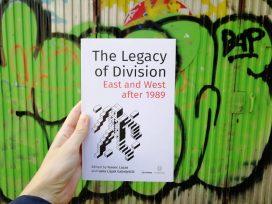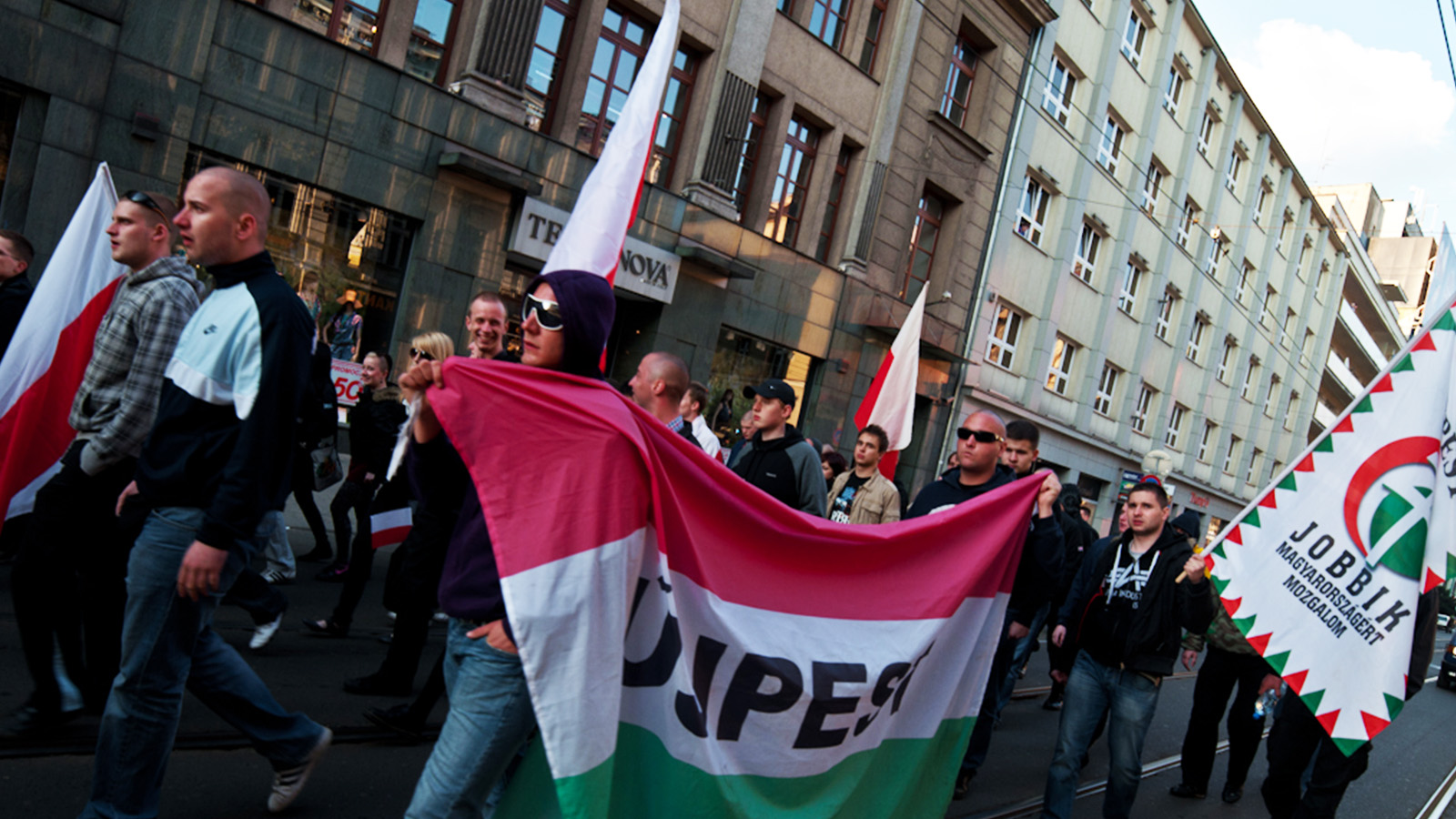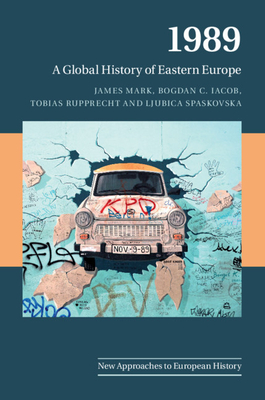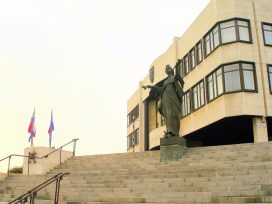
The legacy of division: dual book launch
Watch the discussion of authors and curators #EMCJ31
What is racism against eastern Europeans? And what did Viktor Orbán learn from Slavoj Žižek?
Eastern Europe is clearly part of a global populist wave, and is now part of the western right-wing populist imaginary as the bedrock for ‘pure’ European values. Only by looking at ‘1989’ from a new angle can we see how populist governments’ rejection of a ‘decadent’ and ‘imperialist’ West merely continues a communist stance, despite their strident anti-communist rhetoric.
The spread of populist governments in eastern Europe over the last decade, and their nationalist challenging of core tenets of western liberalism, has given currency to talk about a ‘new east-west divide’. A notion has taken hold that draws on a longer history of western views of eastern backwardness: a specifically eastern illiberal ‘infection’ is allegedly threatening the stability of the entire European project. In this vein, former US Secretary of State Hillary Clinton called upon ‘the EU and the people of Europe to resist the backsliding we are seeing in the east’.1 Yet the parallel ascent of populist parties in much of the West, and a wave of anti-populist mass protests in the east, suggest the divide is not defined by geography alone.
As we argue in 1989: A Global History of Eastern Europe, the current wave of east European populism, while rooted in local nationalist traditions, is best understood by also considering its global ideological bedfellows. Nativists in eastern Europe, and those who embrace similar forms of ethnonationalist cultural traditionalism elsewhere, have mutually reinforced each other. Radical right-wing figures in western Europe have developed strong bonds with eastern European populists in a common push to ‘re-found’ Europe on an explicitly anti-liberal basis. Beyond Europe, leaders with an authoritarian bent, from the right-wing of the Republican Party in the United States, to Vladimir Putin in Russia, Recep Tayyip Erdoğan in Turkey, and Xi Jinping in China, have contributed to eastern European populists’ re-positioning against the West. Through these relationships, leading figures of such nationalist parties as PiS in Poland and Fidesz in Hungary, as well as their intellectual supporters, re-imagined their place in a broader world beyond the liberal rule of law and what they consider the neo-colonial interference of the EU in their countries’ domestic affairs. Together, they clamour for the defence of their societies’ ‘Europeanness’, allegedly threatened by Western multiculturalism, cosmopolitanism, and ‘political correctness’.
This article is also published in the anthology The Legacy of Division: East and West after 1989, published in English and in Slovenian. Listen to one of the authors, Bogdan Iacob discuss his take with three other contributors at the dual book launch.
The EU may be a frequent target of the anger of east European populists, but dismissing them as ‘anti-European’ misses the point. They rather see themselves as the defenders of the ‘true’ – white, Christian, heterosexual – Europe supposedly abandoned in the West. The combination of their own citizens’ migration westwards, and the seeming imposition by the German chancellor Angela Merkel of a ‘welcome culture’ and refugee quotas for Muslim migrants from North Africa and the Middle East, further entrenched a fear of demographic decline. Eastern Europe had, indeed, been the only world region to experience population loss in the twenty-first century. In more recent years, populists garnered support through a political rhetoric that accommodated such fears and defended national strength that was, they alleged, about to be undermined through mass immigration and the western-supported erosion of traditional family values and gender roles.
This self-definition as the valiant trailblazers of the struggle against threats from western decadence developed in interaction with the wider world, occasionally stoked by right-wingers from the West who legitimized their own projects as part of new alliances to defend ‘true Europe.’ As early as 2003, commenting on eastern European states’ support for the Iraq War, the Republican US Defence Secretary Donald Rumsfeld distinguished between a feminized ‘old’ Europe and a virile ‘new’ Europe whose suffering under communism enabled it to fully comprehend the struggle to protect Western civilization. Through the 2000s, Republican Party advisor Arthur J. Finkelstein consulted governments across eastern Europe. It was he who suggested the campaigns against the US finance billionaire and philanthropist George Soros as a political strategy for Viktor Orbán’s self-professed ‘illiberal democracy’ in the 2010s. US President Donald Trump also reinforced this view of east European populism during a state visit to Warsaw in July 2017, insisting that Poland (‘the soul of Europe’) was an example for the will to defend this civilization from the enemies coming ‘from inside or out, from the south or the east, that threaten to […] erase the bonds of culture, faith and tradition that make us who we are’.2
In the reunited Germany of the 1990s, western right-wing groups and figures sought contact with like-minded fellow Germans in the former Democratic Republic. Björn Höcke, today a leading figure of the radical, Völkisch wing of the AfD in Thuringia, had moved from the Federal Republic to become a teacher and political activist in a part of the country he saw as less tainted by immigration, Americanization, and multiculturalism. Like Höcke in the former GDR, the rising western European populist- and far-right, from Matteo Salvini to Marine Le Pen, encouraged eastern Europeans to see themselves as the last true defenders of Europe – from a region whose long history as bulwark against a ‘Muslim threat’ could be remobilized in the present. It was partly due to them that leaders such as, most notably, Hungary’s Viktor Orbán came to see themselves as not only the keepers of the ‘pure’ East, but also the vanguard of a pan-European struggle against multiculturalism and Islam.

Far-right groups from all over eastern Europe march in Katowice. Photo by Marcin Lachowicz on Flickr.
Eastern Europe is clearly part of a global populist wave and now functions as a foundational site in the imagination of many western right-wing populists where the values of an ethnonationally defined Europe can be preserved. But there are specific regional factors which explain both this populist upsurge and the power and radicalism of nativist nationalism in former socialist countries. We need to view communism and its collapse in different ways to make sense of this latest geopolitical transformation of the region.
Eastern Europe is constituted by an ‘in-betweenness’. Sometimes it looked west, but often located itself between east, west, and south. We may see the recent turn away from western liberalism as merely the latest manifestation of a much longer-term history of shifting regional symbolic geographies and ideological frames. Indeed, since the nineteenth century, the question of escaping peripheralization and backwardness on the European continent had been key for east European elites. Communism itself was, in its early years, underpinned by the assumption that the nations in this region had to be wary of the West, and that only through autarkic development, and the cultivation of alternative global relationships, could they catch up and escape their historic role as western Europe’s economic and cultural hinterland.
This sense of difference in eastern Europe was reinforced by outsiders as China’s rhetoric of a ‘common ground’ with the region based on past exploitation by the West fell on fertile ground. The Czech president Miloš Zeman, during his 2015 visit to Beijing, explained that the two states were brought together by similar experiences of ‘one hundred years of humiliation’, as the Czech Republic had been caught between Russia and Germany with post-1989 governments were ‘very submissive to the pressure from the US and from the EU’.3
If populist leaders now promise economic development and the reassertion of national dignity through a certain distancing from Brussels, Paris, or Berlin, it is only the next episode in a longer-term history of reimagining their place in the world. A key reason behind this latest change of orientation of the region away from the West was the economic and financial crisis after 2008 – less due to its direct economic effects in the region – which were, if severe in some countries, still less grave than in the South of the continent – but because the crisis chipped away at the image of western Europe as role model for domestic reform.
Another reason for the impressive current popularity of such political figures as Orbán or Kaczyński can be found in the communist period itself. Contrary to the view that the recent populist turn is a marker of a ‘new’ continental divide, the political shift in eastern Europe in the 2010s was long in the making. Populist governments, their fervent anti-communist rhetoric notwithstanding, actually stand in continuity to some of the populist anti-Western traditions of pre-1989 state socialism. Stereotypes of a both weak and morally dissolute West unprepared to stand up for white, Christian, European civilization can draw on tropes about the ‘decadent’ and ‘imperialist’ West dating from the post-1945 decades. Sloganeering about internationalism, the nation, and nationalism had, after all, been used and instrumentalised by rulers in all communist countries. They presented the world abroad, and especially the liberal West, as dangerous and used ‘cosmopolitan’ as a derogatory term for those they condemned as decadent globalist capitalists. The ‘national’ and ‘the people’, by contrast, were typically embraced in communist political rhetoric and state-sponsored culture.
Populists recently picked up this strategy of positioning the national homeland, and the state with its generous welfare programmes for families, as protectors from the hardships of globalization. Communists as much as populists used anti-globalist, and sometimes antisemitic, rhetoric to promote themselves against internationally-connected representatives of finance capitalism, ‘neoliberal globalizers’, and ‘neocolonial bureaucrats’ that sought, in their view, to undermine the sovereignty of the nation.
To understand the rise of populism, we need to rethink the 1989 revolutions. They amounted not only to the victory of westernizing liberalism, but were also littered with authoritarian, populist, and socialist visions. Most of these may have been ‘disciplined out’ by the idea of transition, but reemerged in the late 2000s. East European liberal elites shared with many westerners a notion of ‘1989’ as a democratic breakthrough. They saw the extraordinary convergence of marketization, democratization, self-determination, and westernization as a historically necessary ‘catching up revolution’ to overcome authoritarianism and backwardness. While western and east European liberals promoted this teleological story of ‘1989’ as a staging post on the road to the east’s inevitable integration into western politics and culture, many east Europeans never identified with what they perceived as a forced and alien reading of their nations’ histories.
Liberalism in eastern Europe was thus largely a creation of 1989, not its cause. The predominant form of exit from communism, i.e. the one negotiated by liberally-inclined dissidents and reform communists, fuelled a sense of estrangement amongst those in eastern Europe who felt excluded from this ‘pact of the elites’. Contemporary illiberalism ties visions and ideas of the transition period and draws on the discontents to post-1989 transformations. It points at the fact that some former representatives of the communist party-states had remained in dominant economic positions after 1989 and present this as the original sin of the new eastern Europe. Such rhetoric is most successful in those parts of formerly state socialist Europe where people feel they did not profit, or profited less than others, from the changes of 1989.
Radical critiques of post-1989 establishments and their pro-Western consensus has exploited real imbalances in the post-EU enlargement development of the region. Discontent with the structural dislocation caused by the disappearance of entire sectors of local economies, along with the social networks that had sustained them, fuelled broader critiques of the entire transformation. One of the striking elements of some eastern Europe societies indeed remains the rather low support for liberal democracy. A 2017 Pew Centre study showed that support for democracy was at a mere 47 per cent in Poland, 48 per cent in Hungary, 39 per cent in Bulgaria, 34 per cent in Latvia, and only 25 per cent in Serbia. Yet such ambivalence was not absent from the 1989 revolutions; it was the dark side of the annus mirabilis with its often overlooked legacies of violence, ethnic strife, and new geopolitical segregation between East and West as well as North and South.
Moreover, before the late 1980s, only a minority among the oppositions to state socialism had been supporters of what, in the 1990s, emerged as a liberal elite consensus on political-civic rights, multiparty systems, free elections, and the free market. On the one hand, ideas of a democratic socialism survived to varying degrees while some conservative, nationalist dissenters rejected liberalism altogether. For example, Solidarność, the largest opposition movement of the communist period, was wedded to incremental reform and the protection of workers’ rights, while Catholicism played a crucial role in the self-identification of its rank and file.
On the other hand, enthusiasm for authoritarian capitalist modernization was already present. In the 1980s, party experts in Hungary, Poland, and Czechoslovakia argued for the necessity of deregulation, privatization, and opening up to world markets to create modern and efficient economies. This could, they said, be effectively undertaken by nominally communist one-party dictatorships following the road of Franco’s Spain, Pinochet’s Chile, or the east Asian ‘Tigers’. This vision may have been defeated in 1989 but, in the 2010s, leaders like Orbán revived comparable agendas, imagining the region could benefit from copying elements of the economically dynamic illiberalism of Singapore or even China.
Another temporarily marginalized strand of ‘1989’ was the fear that ‘the return to Europe’ would trigger a westernization of local cultures and societies, undermining their alleged authenticity, already weakened by foreign-imposed communist rule. In the 1990s Christian, conservative, and nationalist groups expressed anxieties about how a new European cosmopolitanism could break the bonds of the ‘cultural nation’. This is an important thread upon which populists have woven their critiques of what they see as the unfulfilled recognition of the East as equal to the West. They exploited the – rather implicit but sometimes explicit –civilizational hierarchies inherent to European integration, presenting themselves as advocates of national liberation against post-1989 subordination to the West. Along the way, their cultural and moral critique of the EU strikingly resembles the anti-colonial narratives initially employed in former socialist states by oppositionists against the Soviet Union during the Cold War.4
For almost two decades, populist politicians and pundits rejected ‘1989’ as the symbol of convergence with a liberal West by ideologically weaponizing the alternatives present during socialism’s collapse and in the early years of its aftermath. The illiberal discourses on national sovereignty, peddled by east European populists in concert with their counterparts in the West, as well as regimes such as those in Russia or China, have altered the civilizational script for east European development, namely that liberal democracy was the sole model for former socialist societies.

Fidesz and the far-right demonstrations in Hungary. Photo by almodozo on Flickr.
In recent years, however, ‘1989’ as a usable symbol has returned across the political spectrum. On one side, it remains a powerful mobilizing symbol for politicians and a new generation of civic activists committed to defending and developing liberal institutions, the rule of law, and democratic values, and demanding greater state accountability and transparency. As much as the current populist wave draws upon illiberal historical traditions with deep roots in the region, there are forms of resistance against it that build on local and transnational traditions of dissent and often invoke ‘1989’ to claim their own progressive interpretation of the recent transformations. In Poland, a movement has coalesced around the magazine Krytyka Polityczna (Political Critique). It aims to recuperate the sense of experimentation and participatory politics that had been popular around 1989, invoking concepts of direct democracy and self-organisation that had been expounded by pre-Martial Law Solidarność or by dissidents such as Václav Havel or Jacek Kuroń. In Prague, during the twentieth anniversary of the ‘Velvet Revolution’, students lambasted Czech politics and politicians by redeploying the moral critique articulated by dissidents against the decaying socialist regime.
Over the last decade, a veritable wave of anti-regime demonstrations has challenged populist and authoritarian regimes across eastern Europe. These drew on the liberal narrative of ‘1989’ as a symbol of Western-facing resistance against new populisms and of the unfulfilled hopes of substantial democratic transformation across the region. Bulgarian demonstrators chose 10 November, the day of the toppling of the communist leader Todor Zhivkov in 1989, for their 2013 ‘March of Justice’ protest that called for governmental accountability and the defence of pluralism. Memories of the 1989 era and the possibilities of western integration were also enthusiastically reignited in 2013 by the Maidan protests in Ukraine. In Bucharest, protesters against local social democrats’ attempts to dismantle the rule of law and institutionalize corruption identified with the civil disobedience and revolt that had been the basis for the revolution against Nicolae Ceaușescu.
In Slovakia, where the outrage over the assassination of a journalist drew massive crowds into the streets in March 2018 to denounce the corruption sponsored by the ruling party SMER, symbols of the Velvet Revolution have been re-employed, and representatives of Verejnosť proti násiliu (Public Against Violence), the leading opposition movement in the country in 1989, have revived their political activism. In Serbia, tens of thousands of demonstrators opposed to the autocratic rule of President Aleksandar Vučić have invoked the legacy of the ‘Bulldozer Revolution’ fought against Slobodan Milošević. Russian journalists who recently protested against the treatment of their colleague Ivan Golunov chose to do so on 12 June, the national holiday that commemorates Russia’s declaration of state sovereignty in 1990. Last but not least, in the Czech Republic, where a large protest movement has emerged against the populist regime’s power abuse and embezzlement, plans are currently being developed for a mass demonstration on 16 November – the 30th anniversary of the beginning of the Velvet Revolution.
Moreover, the recuperation of ‘1989’ as symbol of anti-authoritarian resistance took a global dimension in 2019. Major protests in Hong Kong organized against the attempt of China to establish its right to extradite criminals – seen as a major legal incursion of communist Beijing – draw on the repertoires of protest from 1980s eastern Europe. Human chain ‘The Hong Kong Way’, on 23 August 2019, was inspired by the similar initiative organized by Baltic peoples on the same day in 1989 during their push for independence from the Soviet Union. So-called ‘Lennon Walls’ in subway stations filled with post-it notes demonstrating ordinary citizens’ solidarity with the protestors consciously draw on its original manifestation in Prague in 1988, where Czechoslovak citizens could express their disenchantment with the communist regimes. Such walls then proliferated across major world cities in order to express international solidarity with the Hong Kong protests.
On the other hand, following thirty years of decrying the revolutions of 1989 as a ‘betrayal’, right-wing populists began to embrace the power of the memory of that year at its thirtieth anniversary. Recognising that the power of the 1989 story had not receded internationally, and having marginalized liberal opponents at home, such figures gained the political self-confidence to embrace and rewrite the story of these years. They continue to reject the idea of the end of communism as a liberal breakthrough. Rather, they promote the 1989 as the beginning of a long journey towards the recovery of a Christian anti-communist Europe. In this re-reading, the roles of later populist Prime Ministers – most notably Jarosław Kaczyński and Viktor Orbán – became the heroes of the show. The former, who played a minor role at the Round Table talks, became eulogized before its more august participants. PiS representatives pressurized memorial institutions to pay greater attention in their exhibits to PiS leader Lech Kaczyński (who died in a plane crash in 2010) and less to Lech Wałęsa, Solidarity’s founder and former President of Poland. At the ‘Freedom Concert’ at Heroes Square in Budapest on 16 June 2019 – on the 30th anniversary and exact site of the 1989 reburial of Imre Nagy, the reform communist leader who was executed in 1958 – the promotional video which looped between performances not only showed the reburial without naming the person reburied, but also focussed almost exclusively on Orbán’s 1989 speech demanding the withdrawal of Soviet troops, relayed against the soundtrack of Scorpions’ ‘Wind of Change’.5 The right-wing leader of Fidesz had displaced the leftist figurehead who had symbolized change in that year – and the monument to whom outside the Hungarian parliament was removed some five days before the anniversary year began. At the 1989 exhibition at Budapest’s House of Terror, Orbán and the ‘Hungarian people’ replace important figures such as the reform communist Gyula Horn or the various left, liberal, and conservative groups and movements that had fought against the system for much longer.6 The right was no longer attempting to contain the power of 1989, but rather to harness it for the conservative counterrevolution.
The eastern European struggle over ‘1989’ has thus reached a pinnacle during its 30th anniversary. The right-wing attacks against ‘1989’ as a symbol of a liberal transition, which long reflected the cultural, social, and economic anxieties reactivated by the steady delegitimization of post-communist establishments and a lingering sense of ‘peripheralization’ in Europe, are now complemented by a historical revisionism in which the revolutions are reimagined as ‘year zero’ for a conservative counterrevolution. At the same time, the liberal script of ‘1989’, though no longer central in east European politics today, holds significant value among newly mobilized progressive civic groups. As liberalism is increasingly contested in western Europe, the idea of convergence with the liberal democratic West embodied by ‘1989’ has been transformed, by significant minorities in most eastern European countries, into a powerful symbol of resistance against newly hegemonic populisms, ethnocentrisms, and supposed cultural differences from Western values.

Together with Ljubica Spaskovska, the three writers of this essay are co-authors of 1989. A Global History of East Europe (Cambridge University Press, 2019).
https://www.theguardian.com/us-news/2018/oct/09/hillary-clinton-criticises-tory-meps-over-failure-to-censure-hungary.
https://time.com/4846924/read-president-trumps-remarks-on-defending-civilization-in-poland/.
Bartosz Kowalski, ‘China’s Foreign Policy towards Central and Eastern Europe: The 16 +1 Format in the South–South Cooperation Perspective. Cases of the Czech Republic and Hungary’, Cambridge Journal of Eurasian Studies, 1/2017, 7
Paul Betts, '1989 at Thirty: A Recast Legacy', Past and Present 1/2019, 271-305.
Gergő Plankó, ‘Real freedom is when the leader of a state party is broadcast on a loop on a festival’s main stage’ (‘Az igazi szabadság az, amikor az állampárt vezetőjét végtelenítve adják egy fesztivál nagyszínpadán’), 27 June 2019: https://444.hu/2019/06/27/az-igazi-szabadsag-az-amikor-az-allampart-vezetojet-vegtelenitve-adjak-egy-fesztival-nagyszinpadan
László Szily, ‘Petty historical fraud, but is at least hilariously self-reveling street exhibition on the regime change by Mária Schmidt’ (‘Kicsinyes történelemhamisítás, de legalább viccesen önleleplező Schmidt Máriáék utcai rendszerváltás-kiállítása’, 444.hu, 17 June 2019. https://444.hu/2019/06/17/kicsinyes-tortenelemhamisitas-de-legalabb-viccesen-onleleplezo-schmidt-mariaek-utcai-rendszervaltas-kiallitasa
Published 3 September 2019
Original in English
First published by Eurozine
Contributed by Bogdan Iacob / James Mark / Tobias Rupprecht © Bogdan Iacob / James Mark / Tobias Rupprecht
PDF/PRINTSubscribe to know what’s worth thinking about.

What is racism against eastern Europeans? And what did Viktor Orbán learn from Slavoj Žižek?

The climate of hostility in which the assassination attempt on Robert Fico took place has been a feature of Slovak politics for the past two decades. And Fico has played a decisive role in creating it. How the situation in Slovakia came about – and whether it will continue to deteriorate.